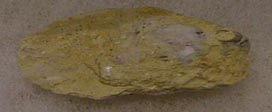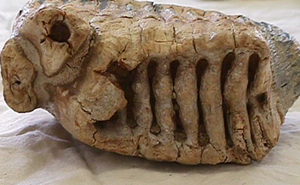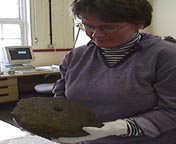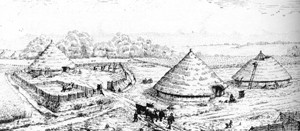

Prehistory - The landscape of Milton Keynes has been through some startling changes. In the very depths of prehistory this whole area would have been the ocean floor. Fossil finds in other parts of the new city include Ichthyosaurs, Ammonites, Belemnites and Geryphaea, all marine animals from the age of dinosaurs. In the Milton Keynes village area scientific research on river gravels has produced fossilised brachiopods (below, right) from the Middle Jurassic period, about 220 million years ago.
Moving into the Pleistocene period, about 2 million years ago, it seems likely that the River Ouzel was much larger than at present. The whole area would have been extremely wet and swampy and liable to extreme flooding. Large dense areas of woodland would have also been present. Whilst man was around no evidence of his existence has been found in the area of Milton Keynes village. Discoveries do, however, include remains of horse, ox and mammoth. In 1990 a tooth from a juvenile mammoth of the Pleistocene period was discovered on a spoil heap, in the workings of the Hartigans gravel pit.
Moving into the Pleistocene period, about 2 million years ago, it seems likely that the River Ouzel was much larger than at present. The whole area would have been extremely wet and swampy and liable to extreme flooding. Large dense areas of woodland would have also been present. Whilst man was around no evidence of his existence has been found in the area of Milton Keynes village. Discoveries do, however, include remains of horse, ox and mammoth. In 1990 a tooth from a juvenile mammoth of the Pleistocene period was discovered on a spoil heap, in the workings of the Hartigans gravel pit.






Iron Age - Evidence of first human settlement appears in the Iron Age. Proof of this appears in the shape of two quernstones found on separate occasions in Milton Keynes village. Quernstones are very heavy and would not have been transported by the inhabitants. They were used by hand as milling stones. The example below measures nine inches in diameter and is made from Hertfordshire puddingstone which naturally occurs in this area and resembles modern day 'pebble-dashing'.


(By Brian Giggins)


Roman - Watling Way is one of the most famous links within the Milton Keynes area with Roman Britain. Boudicca travelled from London to St. Albans raging against the Romans along the lenghth of Watling Way.Allegedly her last battle taking place in Towcester. Settlements appeared either side of the road notably Bancroft Villa.The local British tribe were the Catuvellauni who occupied Hertfordshire, Cambridgeshire and Buckinghamshire and an area north of the River Thames. Shards of Roman pottery were found around the Church in Milton Keynes village when maintenance work was carried out. A silver brooch with a dagger shaped pin was discovered in the village. Usually brooches of this time, were bronze sometimes tinned to give a silver appearance. In 1993 a segment of an upper rotary quernstone was found by a recently disturbed verge substantiating evidence of Roman settlement in the village.



